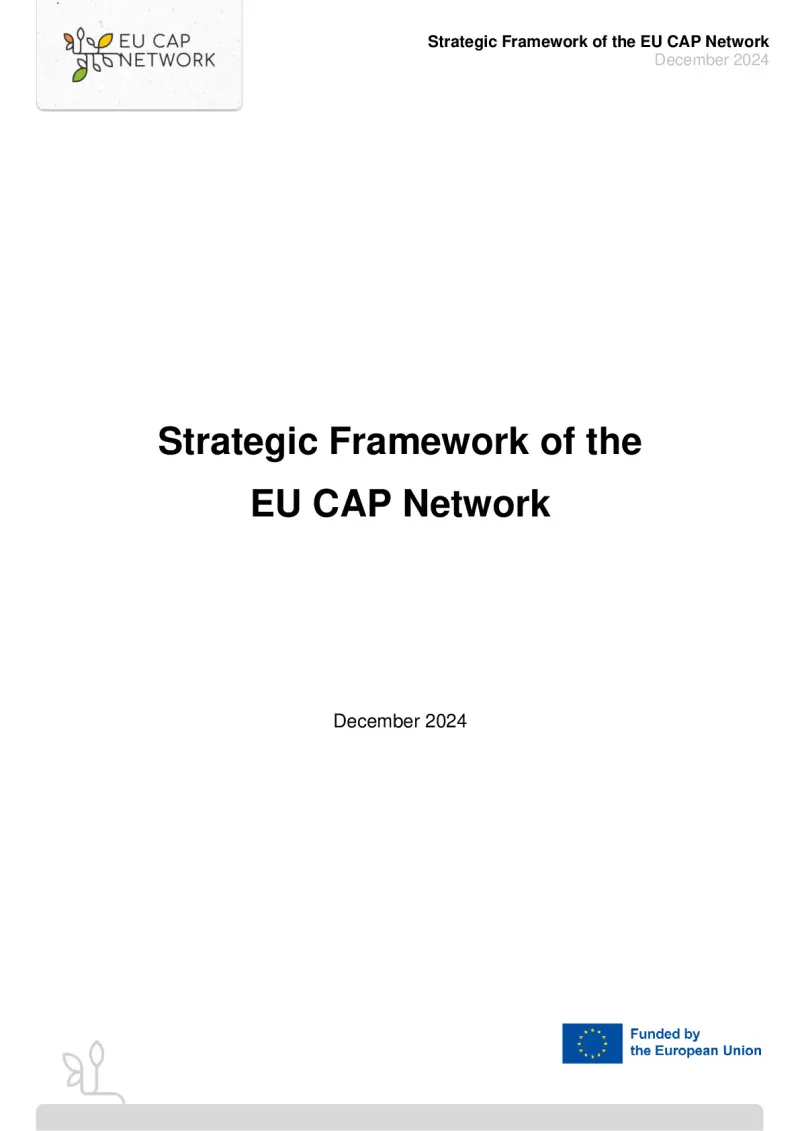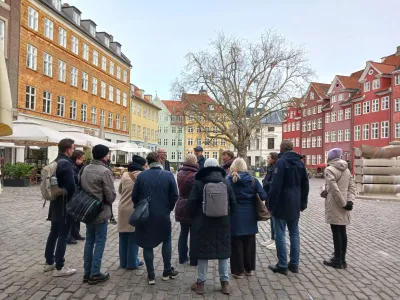Ein strategischer Governance-Rahmen für das EU-GAP-Netzwerk
Eine gute Führung trägt dazu bei, dass jede Organisation besser funktioniert. Erfolgreiche Führungssysteme und -strukturen basieren auf faktengestützten Entscheidungen, und dieser strategische Ansatz wird auch auf die Führung des EU-GAP-Netzwerks angewendet.
- Programming period: 2023-2027

Page contents
In der Politikwissenschaft bezieht sich „Good Governance“ auf die Art und Weise, wie Entscheidungsbefugnisse von Behörden des öffentlichen und privaten Sektors ausgeübt werden, einschließlich derer, die die Gemeinsame Agrarpolitik (GAP) der EU unterstützen. Eine gute Regierungsführung bei GAP-finanzierten technischen Hilfsinitiativen wie dem EU-GAP-Netzwerk dient dazu, die Wirksamkeit, Transparenz und Rechenschaftspflicht von GAP-Netzwerkaktionen zu gewährleisten, die darauf ausgerichtet sind, das volle Potenzial der GAP auszuschöpfen. Good Governance trägt auch dazu bei, das Vertrauen der Interessenvertreter der GAP in das Netzwerken zu stärken und ihr Engagement dafür zu fördern.
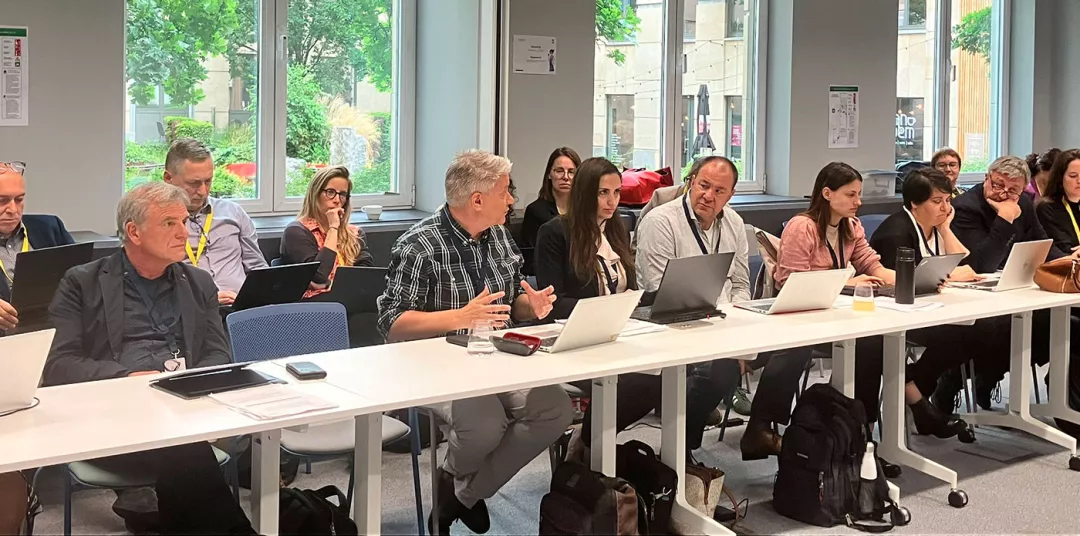
Die Leitung des EU-GAP-Netzwerks umfasst eine Versammlung und ihre Lenkungsgruppe. Die Versammlung hat außerdem drei ständige Untergruppen, die sich jeweils mit den GAP-Strategieplänen (SoCSP), LEADER und territorialer Entwicklung (SoLTD) sowie Innovation und Wissensaustausch (SoIKE) befassen.
Die Leitungsorgane sind repräsentativ für das breitere Spektrum der Interessenvertreter des EU-GAP-Netzwerks, sodass der laufende Dialog mit diesen Gremien, auch durch spezielle Veranstaltungen, sicherstellt, dass das EU-GAP-Netzwerk mit der Basis verbunden ist. Regelmäßige Konsultationen stellen außerdem sicher, dass das jährliche Arbeitsprogramm des EU-GAP-Netzwerks die Hauptprioritäten seiner Interessenvertreter widerspiegelt und sich auf aufkommende Fragen und wichtige Themen in der Landwirtschaft und der ländlichen Entwicklung für den GAP-Finanzierungszeitraum 2023–2027 konzentriert.
Strategisches Netzwerken
In derselben Verordnung zur Einrichtung des EU-GAP-Netzwerks wurden auch die Governance-Mechanismen festgelegt und die Governance-Mitglieder benannt. Um erfolgreich zu sein, ist dieses politikbasierte Governance-System auf Klarheit und Konsens darüber angewiesen, wie Erfolg definiert wird.
Der Erfolg des EU-GAP-Netzwerks wird anhand der Ziele für die GAP-Vernetzung (gemäß Artikel 126 der EU-Verordnung über GAP-Strategiepläne) bewertet. Diese Ziele sind in Abbildung 1 dargestellt.
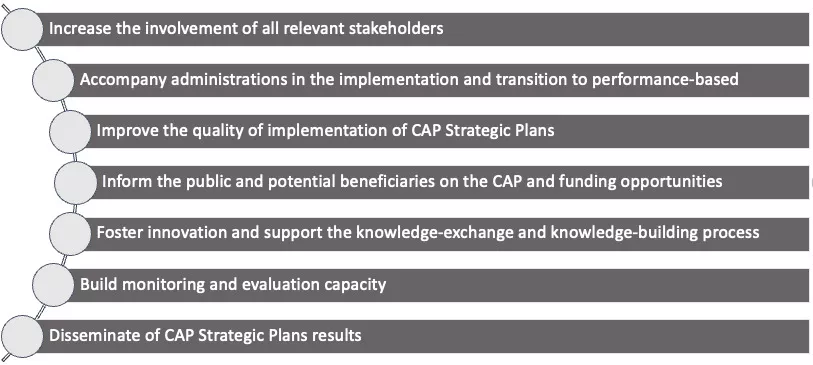
Hier kommt der Strategische Rahmen als wertvolles Instrument zur Bewertung des EU-GAP-Netzwerks ins Spiel. Der Strategische Rahmen wurde von den Netzwerk-Support-Einheiten gemeinsam für die Leitungsorgane entwickelt. Ein Arbeitsentwurf des Strategischen Rahmens wurde den Mitgliedern der Lenkungsgruppe im Oktober 2024 zur Kommentierung und Stellungnahme vorgelegt. Er wurde daraufhin überarbeitet, verfeinert und den Mitgliedern der Versammlung vorgelegt und auf ihrer letzten Sitzung im Dezember 2024 validiert.
Der Strategische Rahmen hat folgende allgemeine Ziele:
- Bereitstellung eines einheitlichen und allgemein verständlichen Rahmens für die Arbeit des EU-GAP-Netzwerks
- Anleitung und Sicherstellung der Koordination zwischen den Netzwerk-Support-Einheiten bei der weiteren Ausarbeitung ihrer Aktivitäten
- Unterstützung der Leitungsgremien des EU-GAP-Netzwerks bei der Angleichung der Prioritäten der Netzwerk-Support-Einheiten
- Schaffung der Grundlage für die Überwachung und Bewertung der Aktivitäten des EU-GAP-Netzwerks
Der Strategische Rahmen betrachtet die Aktivitäten des EU-GAP-Netzwerks als Ganzes innerhalb einer einzigen Interventionslogik. Er berücksichtigt, dass die verschiedenen Netzwerk-Support-Einheiten, die für die Umsetzung der GAP, Innovation und den Wissensaustausch, die Bewertung und die Kommunikation verantwortlich sind, alle auf unterschiedliche Weise zur Umsetzung und zum Erfolg der Netzwerkziele beitragen.

Erfolgsfaktoren
Bei der Überlegung, wie sich der Erfolg in Bezug auf die in der Verordnung festgelegten Ziele des Netzwerkens darstellen lässt, wurde eine Reihe von „Erfolgsfaktoren“ entwickelt. Dies geschah, um die Operationalisierung der Ziele zu erleichtern und eine Grundlage für die Messung zu schaffen, ob das EU-GAP-Netzwerk diese erfolgreich erreicht hat.
Zu den Erfolgsfaktoren gehören beispielsweise die Steigerung des sinnvollen Engagements von Interessenvertretern, der Austausch von Informationen und die Schaffung von Möglichkeiten zum Austausch über erfolgreiche Beispiele für die Umsetzung von GAP-Strategieplänen (LSP), die Analyse und Verbreitung sich entwickelnder Trends in der Landwirtschaft und der ländlichen Entwicklung, der Austausch erfolgreicher innovativer und forschungsbezogener Ansätze, die Schaffung von Räumen, in denen Interessenvertreter zusammenkommen können, die Verbesserung der Qualität von Überwachungs- und Bewertungsaktivitäten und die Sicherstellung, dass die Ergebnisse der LSP mit Unterstützung der nationalen Netzwerke für die GAP in den Mitgliedstaaten einem breiten Publikum zugänglich gemacht werden.
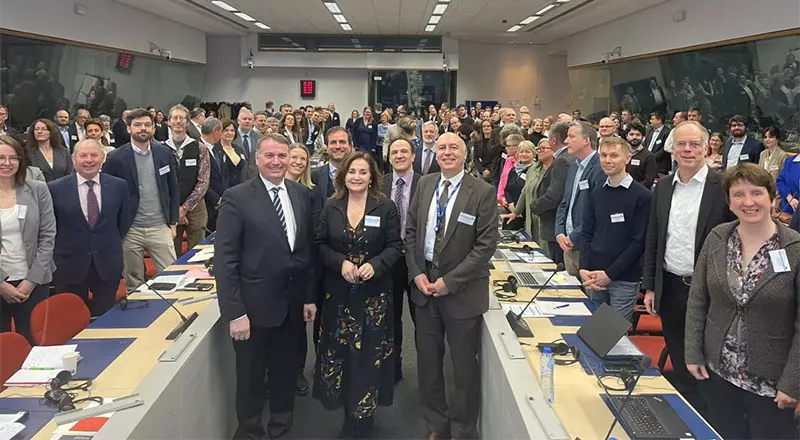
Die weitreichenden und vielfältigen Aktivitäten des EU-GAP-Netzwerks sind mit der Darstellung der Erfolgsfaktoren verbunden, und quantitative und qualitative Daten aus diesen Aktivitäten werden regelmäßig gesammelt. Der Strategische Rahmen erkennt an, dass viele der Aktivitäten des EU-GAP-Netzwerks mit mehreren Zielen des Netzwerkens in Zusammenhang stehen und dass die Kombination der Aktivitäten der verschiedenen Netzwerk-Support-Einheiten das Umfeld mit mehreren Interessenvertretern widerspiegelt, das an der Basis besteht.
Dank dieses gemeinsamen Überwachungsinstruments erhalten die Leitungsorgane des EU-GAP-Netzwerks nützliche Informationen darüber, wie die Hauptziele des Netzwerks erreicht werden. Die aus dem Strategischen Rahmen abgeleiteten Informationen können gute Einblicke bieten, um sicherzustellen, dass die Netzwerkaktivitäten von den verschiedenen Interessenvertretern als „sinnvoll“, „relevant“ und „angemessen“ angesehen werden.
Solche Daten werden auch dazu beitragen, evidenzbasierte Governance-Entscheidungen zu treffen, z. B. um Wege zu finden, die Unterstützung, die das EU-GAP-Netzwerk verschiedenen Arten von Interessenvertretern zur Erreichung seiner Ziele bieten kann, zu koordinieren und zu optimieren.
Die Berichte über die Sitzungen der Versammlung und der Lenkungsgruppe enthalten ausführlichere Informationen zu den von den Mitgliedern diskutierten Themen und zur Arbeit der Leitungsgremien des EU-GAP-Netzwerks.
Author(s)
EU CAP Network
